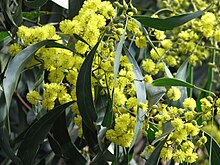Acacia pycnantha
| Golden wattle | |
|---|---|

| |
| Scientific classification | |
| Kingdom: | Plantae |
| Clade: | Tracheophytes |
| Clade: | Angiosperms |
| Clade: | Eudicots |
| Clade: | Rosids |
| Order: | Fabales |
| Family: | Fabaceae |
| Subfamily: | Caesalpinioideae |
| Clade: | Mimosoid clade |
| Genus: | Acacia |
| Species: | A. pycnantha
|
| Binomial name | |
| Acacia pycnantha | |

| |
| Occurrence data from AVH | |
| Synonyms | |
|
Species synonymy
| |
Acacia pycnantha, the golden wattle, is a tree. It is the national plant of Australia. The tree is in the family Fabaceae, and is native to southeastern Australia.
The plant grows to 8 m (26 ft) and has flattened leaf stalks (called phyllodes) instead of true leaves. The phyllodes are sickle-shaped, between 9 and 15 cm (3+1⁄2 and 6 in) long, and 1–3.5 cm (1⁄2–1+1⁄2 in) wide.
The fragrant, golden flowers appear in late winter and spring, and then there are long seed pods. Plants are cross-pollinated by several species of honeyeater and thornbill. When birds visit nectaries, the phyllodes brush against flowers. This transfers pollen between them.
The golden wattle is an understorey plant in eucalyptus forests. It is found from southern New South Wales and the Australian Capital Territory, through Victoria and into southeastern South Australia.
